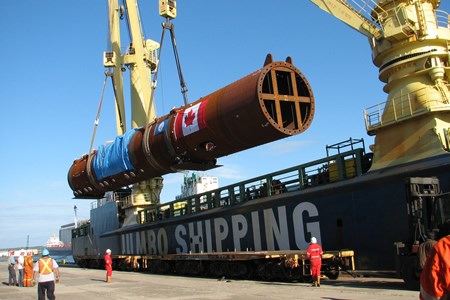Thunder Bay Port Authority's pursuit of Alberta-bound project cargoes went over in a big way last summer.
The M/V Daniella, a heavy-lift jumbo vessel, nosed up to Keefer Terminal in early August to unload a 450-ton reactor headed for the Alberta oil sands.
The voyage to Thunder Bay was the last leg of a 12,249-nautical mile journey from the Port of Higashi Harima, Japan. The reactor will be sent to its final destination this fall at the Canadian Natural Resources' oil sands project in Fort McMurray. The reactor weighed more than 1.3 million pounds.
Thunder Bay Port Authority CEO Tim Heney is working with Canadian National Rail to push similar freight through the port into one contiguous intermodal rail network from the Lakehead port to the doorstep of oil processing sites in northern Alberta.
The authority and the City of Thunder Bay are promoting themselves as an emerging manufacturing and fabrication hub for the Western Canada oil industry.
After more than a year's worth of planning with CN, another jumbo vessel, with an even heavier cargo, is arriving in Thunder Bay Nov. 24, carrying more reactor modules.
A larger ship, the M/V Stella Prima, will complete its month-long voyage from Japan, carrying four reactor modules of 550 tonnes apiece, destined for the oil sands.
"It will be a new record for us," said Heney. "It's a good start and we're looking to a lot more of this type of equipment coming through. Nothing is confirmed, but if we can get up to 10 ships a year (in 2009) we'd be pretty happy."
The first reactor that arrived last summer remains in Thunder Bay. All the modules will be placed on the same train before heading west in early December. The customer is waiting for winter freeze-up in northern Alberta.
Moving the massive cylinder structure used in extracting oil, generated plenty of positive buzz for the port from both the industry trade publications and the mainstream media.
Last summer's arrival of the Daniella has lead to many phone inquiries from shippers and freight-forwarders. "It's put us on the map, no question about it," Heney says.
Handling the heavy reactors are the "showpieces" of what's expected to be more oil sands-related equipment in 2009. Heney wants to see it evolve into other westbound cargoes such as pipe, steel and other processing components.
Working in Thunder Bay's favour is that these types of oversized pieces can't be moved over the Rocky Mountains through the Port of Vancouver.
However, there is still plenty of competition from other North American ports for this kind of business.
A good chunk of the cargoes destined for Alberta are shipped through Houston TX which handles about 11 million tonnes of general cargo annually.
The Port of Duluth, Minn. held an advantage because there were always railway clearance issues between Thunder Bay and Fort Frances. But CN chipped back some rock cuts and upgraded railway bridges in northwestern Ontario to where now Thunder Bay is superior to their U.S. competitor.
In creating one contiguous supply chain to northern Alberta, CN acquired and made upgrades to a short-line railroad from Boyle, Alta. to Fort McMurray to accommodate maximum project cargoes.
"We're trying to be a more competitive gateway and with the partnership with CN, you're on one railway all the way there."
Playing in Thunder Bay's favour are the cost advantages to shippers of not having to pay any harbour maintenance tax as in U.S. ports. Dropping oil prices means developers are more cost conscious. A favourable currency exchange represents a 25 per cent savings to shippers. The rail infrastructure coming into Keefer is no problem and their dock is surveyed every time for each piece depending on the wheel configuration and the number of axles.
Thunder Bay has traditionally been an export port, but more inbound cargoes generates more two-way traffic.
Vessels arriving at the port usually discharge iron ore or coal at steel mills on the lower lakes before heading to Thunder Bay to load grain.
"If we can get an ocean-going ship up here and give it backhaul cargo, we win both ways."
Re-establishing links with Western Canada is the future for Thunder Bay with Saskatchewan poised to be the next province to take off with industrial development.
Heney said if business can be built up, the authority would consider adding high-speed shore cranes and reconfiguring the Keefer Terminal site to create a huge lay-down yard.
They are also looking at purchasing another waterfront site to use as an equipment staging area.
Ultimately he would like to see some partial steel fabrication and assembly work done locally. The Keefer site is about 90 acres, but there's another 100 acres of undeveloped space.
Some local fabricators and suppliers already perform contract work in Alberta through the city's Oil Sands Consortium initiative.
There are also unlimited opportunities for other pieces manufactured farther down the Great Lakes and Seaway chain to be barged up to Thunder Bay and placed on rail, said Heney.
"It's a small community of people involved in this kind of equipment and once you're on the map, they all want to know."




